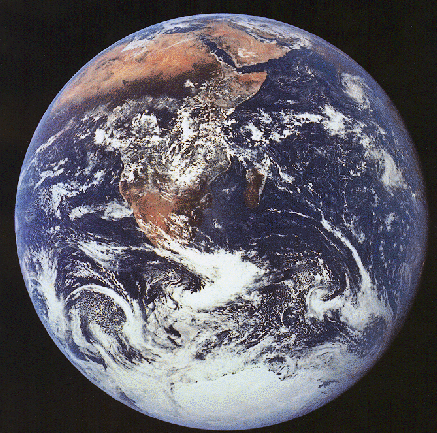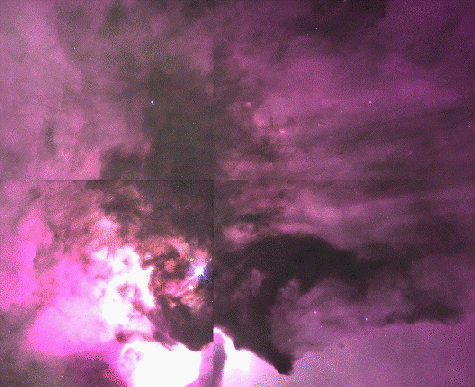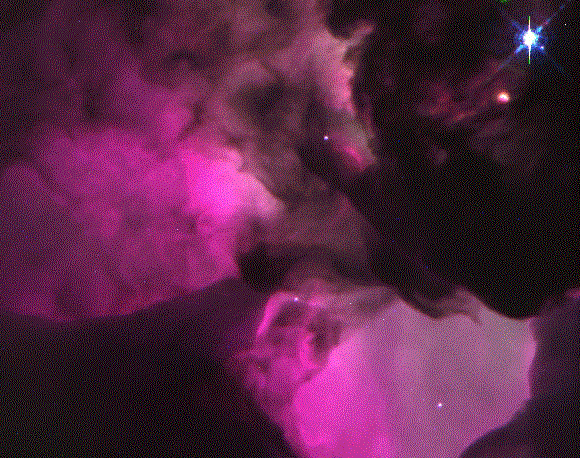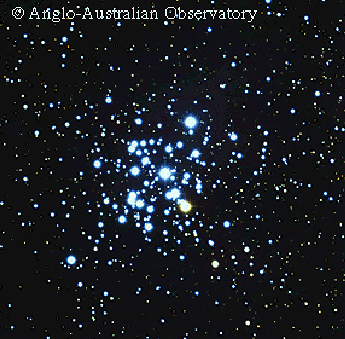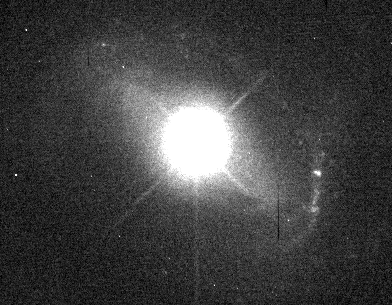NASA APOD #427-433
#427 Tomorrow's picture: August 19, 1996
“Welcome to Planet Earth, the third planet from a star named the Sun. The Earth is shaped like a sphere and composed mostly of rock. Over 70 percent of the Earth's surface is water. The planet has a relatively thin atmosphere composed mostly of nitrogen and oxygen. Earth has a single large Moon which is about 1/4 of its diameter and, from the planet's surface, is seen to have almost exactly the same angular size as the Sun. With its abundance of liquid water, Earth supports a large variety of life forms, including potentially intelligent species such as dolphins and humans. Please enjoy your stay on Planet Earth."
Copyright: Public domain
#428 Tomorrow's picture: August 20, 1996
“Ribbons of red-glowing gas and dark dust surround massive young stars in this close-up of the Lagoon Nebula taken by the Hubble Space Telescope. The Lagoon Nebula is relatively close and bright - it appears larger than the Full Moon and is visible even without a telescope. Light takes about 5000 years to reach here from there. The Lagoon Nebula houses the open star cluster M8. This photograph is combination of exposures taken in the red, green and ultraviolet. The unusual bright central part of the Lagoon Nebula (lower left in this image) is known as the Hourglass Nebula."
Copyright: Public domain
#429 Tomorrow's picture: August 21, 1996
“In the central part of the Lagoon Nebula lies the above pictured Hourglass Nebula. In this region of recent star formation, obscuring dark lanes of dust permeate the red-glowing hydrogen gas. Blocking some of the gas cloud from our view, they chance to create a glowing shape that appears from our vantage point like an hourglass. In the upper right of this picture from the Hubble Space Telescope is a bright young blue star from the open cluster NGC 6530 - visible below center in yesterday's APOD. A recent study of the Lagoon Nebula (M8), has shown that this emission nebula houses large magnetic fields and unusually large dust particles."
Copyright: Public domain
#430 Tomorrow's picture: August 22, 1996
“Is this one galaxy or two? Analysis of Arp 230 has shown evidence that this seemingly single spiral galaxy is actually the result of the recent collision of two spiral galaxies. The slow motion collision took place over about 100 million years and induced a burst of star formation that has begun to subside. The collision apparently had many similarities to the colliding galaxy sequence in the IMAX movie "Cosmic Voyage.""
Copyright: Public domain
#431 Tomorrow's picture: August 23, 1996
“Hot Blue stars shine brightly in this beautiful, recently formed galactic or "open" star cluster. Open cluster NGC 3293 is located in the constellation Carina, lies at a distance of about 8000 light years, and has a particularly high abundance of these young bright stars. A study of NGC 3293 implies that the blue stars are only about 6 million years old, whereas the cluster's dimmer, redder stars appear to be about 20 million years old. If true, star formation in this open cluster took at least 15 million years. Even this amount of time is short, however, when compared with the billions of years stars like our Sun live, and the over-ten billion year lifetimes of many galaxies and our universe. NGC 3293 appears just in front dense dust lane emanating from the Carina Nebula."
Copyright: Anglo-Australian Telescope
Board
#432 Tomorrow's picture: August 24, 1996
“What causes the center of this barred spiral galaxy to light up brighter than almost anything in the universe? The quasar there is a good fraction of the way across our observable universe but appears so bright that astronomers had to use the high resolving power of the Hubble Space Telescope (HST) just to see the host galaxy. HST then resolved something very interesting. Not only was QSO 1229+204 at the core of an unusual barred spiral galaxy, but this galaxy was in the process of colliding with a dwarf galaxy. Gas from this collision quite possibly fuels a supermassive black hole causing QSO 1229+204 to shine so brightly."
Copyright: Public domain
#433 Tomorrow's picture: August 25, 1996
“The Luna 9 spacecraft above performed the first soft landing on another planetary body. Following a series of failures, the Soviet probe touched down in the Moon's Oceanus Procellarum region February 3, 1966. It accomplished this milestone in lunar exploration only shortly after the death of Sergei Korolev, the father of the Soviet Space Program. Reportedly, Korolev's colleagues wished to dedicate the Luna 9 mission to him but were unable to as his role as the Chief Designer was still a state secret. A pole, just visible extending at the lower left, sensed the impact with the lunar surface, triggering the spacecraft to eject the weighted, egg-shaped capsule (upper right). The 250 pound capsule then struck the surface, rolled upright, unfolded four spring actuated petals to steady itself, and transmitted the first views from the lunar surface back to Earth."
Copyright: Public domain
Upvote! Resteem! Comment! As you like it! Thank you for attention!
